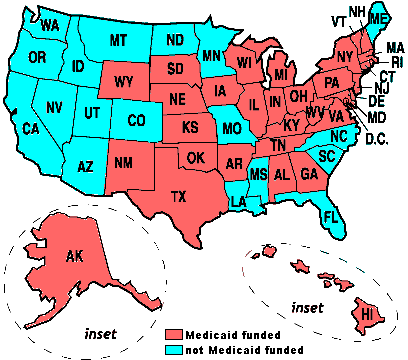Difference between revisions of "Circumcision maps"
WikiModEn2 (talk | contribs) (Create page.) |
WikiModEn2 (talk | contribs) (Add link in SEEALSO section.) |
||
| (19 intermediate revisions by 2 users not shown) | |||
| Line 1: | Line 1: | ||
| − | + | '''{{FULLPAGENAME}}''' are used to graphically display the geographic distribution of the prevalence and/or incidence of male [[circumcision]]. They are also used to indicate which U.S. State Medicaid Agencies have not yet discontinued payments for non-therapeutic circumcision and to indicate the incidence of circumcision in the various U. S. states. | |
| − | '''{{FULLPAGENAME}}''' are used to graphically display the geographic distribution of the prevalence and/or incidence of male [[circumcision]]. | + | |
| + | Prevalence is the percentage of all males (all ages) in a population who have been [[circumcised]]. It does not indicate the present rate (incidence) of circumcision. | ||
| + | |||
| + | == World circumcision map == | ||
| + | |||
| + | This large-scale world map breaks down the prevalence of [[circumcision]] by state in [[Australia]] and the [[United States]]; and by province in [[Canada]]. It is the best one available. | ||
| + | <div class='res-img'>https://i.redd.it/dtmz030tx8a31.png</div> | ||
| + | |||
| + | == Map showing incidence of neonatal circumcision in U.S. hospitals == | ||
| + | |||
| + | We thank [[Saving Our Sons (SoS)]] for providing this map that shows the incidence of non-therapeutic neonatal [[circumcision]] in U.S. hospitals in 2009-10. The incidence of non-therapeutic circumcision is the percentage of newborn baby boys who are being [[circumcised]]. The overall incidence of circumcision of the newborn in the [[United States]] has declined somewhat since this map was prepared. The popularity of infant circumcision in the [[United States]] has been gradually declining for many years. Non-circumcision or [[intactness]] has become the norm among infant boys in many parts of the [[United States]].<ref name="jacobson2021">{{REFjournal | ||
| + | |last=Jacobson | ||
| + | |first=Deborah L. | ||
| + | |init=DL | ||
| + | |author-link= | ||
| + | |last2=Balmert | ||
| + | |first2=Lauren C. | ||
| + | |init2=LC | ||
| + | |author2-link= | ||
| + | |last3=Holl | ||
| + | |first3=Jane L. | ||
| + | |init3=JL | ||
| + | |author3-link= | ||
| + | |last4=Rosoklija | ||
| + | |first4=Ilina | ||
| + | |init4=I | ||
| + | |author4-link= | ||
| + | |last5=Davis | ||
| + | |first5=Matthew M. | ||
| + | |init5=MM | ||
| + | |author5-link= | ||
| + | |last6=Johnson | ||
| + | |first6=Emilie K. | ||
| + | |init6=EK | ||
| + | |author6-link= | ||
| + | |etal=no | ||
| + | |title=Nationwide Circumcision Trends: 2003 to 2016 | ||
| + | |trans-title= | ||
| + | |language= | ||
| + | |journal=J Urol | ||
| + | |location= | ||
| + | |date=2021-01 | ||
| + | |volume=205 | ||
| + | |issue=1 | ||
| + | |article= | ||
| + | |page= | ||
| + | |pages=257-63 | ||
| + | |url=https://www.auajournals.org/doi/abs/10.1097/JU.0000000000001316 | ||
| + | |pubmedID=32716676 | ||
| + | |pubmedCID= | ||
| + | |DOI=10.1097/JU.0000000000001316 | ||
| + | |accessdate=2022-07-14 | ||
| + | }}</ref> | ||
| + | <br><br> | ||
| + | <div class='res-img'>https://i.pinimg.com/originals/03/f5/82/03f582e91f04b3b43e7750ab3af7d71a.jpg</div> | ||
| + | |||
| + | == U.S. Medicaid coverage of non-therapeutic circumcision == | ||
| + | |||
| + | The Congress of the [[United States of America]] created the Medicaid program in 1965 to provide medical care for lower income people. At that time, based on archaic medical data, it was falsely believed that circumcision would prevent penile cancer. Medicaid generally covered non-therapeutic circumcision for that reason. Although Medicaid is a federal mandated program, it is administered by the 50 individual states, which have some options on what services they choose to cover. Circumcision of the newborn is a non-therapeutic surgery, so eighteen states (36%} have elected to discontinue payments for such circumcisions. This map, provided by courtesy of [[Circumstitions - The Intactivism Pages]] depicts in baby boy blue the states which protect boys by refusing to pay for an injurious non-therapeutic amputation of penile tissue. The states where Medicaid still pays for the outmoded operation are depicted in red to indicate the increased danger to boys. | ||
| + | |||
| + | <div class='res-img'>http://www.circumstitions.com/Images/map-usa-notfund.gif</div> | ||
| + | |||
| + | Adler (2011) has argued strongly that Medicaid payments for non-therapeutic circumcision is unlawful.<ref name="adler2011">{{REFjournal | ||
| + | |last=Adler | ||
| + | |first=Peter W. | ||
| + | |init=PW | ||
| + | |author-link=Peter W. Adler | ||
| + | |title=It is lawful to use Medicaid to pay for circumcision? | ||
| + | |journal=Journal of Law and Medicine | ||
| + | |date=2011 | ||
| + | |volume=19 | ||
| + | |issue= | ||
| + | |pages=335-353 | ||
| + | |url=https://www.arclaw.org/wp-content/uploads/2019/04/is-it-lawful-to-use-medicaid-to-pay-for-circumcision.pdf | ||
| + | |quote= | ||
| + | |pubmedID= | ||
| + | |pubmedCID= | ||
| + | |DOI= | ||
| + | |accessdate=2020-05-08 | ||
| + | }}</ref> | ||
| + | {{SEEALSO}} | ||
| + | * [[Australia]] | ||
| + | * [[Canada]] | ||
| + | * [[United States of America]] | ||
| + | {{REF}} | ||
| + | |||
| + | [[Category:Genital cutting]] | ||
| + | [[Category:Male circumcision]] | ||
| + | [[Category:Australia]] | ||
| + | [[Category:Canada]] | ||
| + | [[Category:USA]] | ||
Latest revision as of 15:09, 24 April 2024
Circumcision maps are used to graphically display the geographic distribution of the prevalence and/or incidence of male circumcision. They are also used to indicate which U.S. State Medicaid Agencies have not yet discontinued payments for non-therapeutic circumcision and to indicate the incidence of circumcision in the various U. S. states.
Prevalence is the percentage of all males (all ages) in a population who have been circumcised. It does not indicate the present rate (incidence) of circumcision.
Contents
World circumcision map
This large-scale world map breaks down the prevalence of circumcision by state in Australia and the United States; and by province in Canada. It is the best one available.

Map showing incidence of neonatal circumcision in U.S. hospitals
We thank Saving Our Sons (SoS) for providing this map that shows the incidence of non-therapeutic neonatal circumcision in U.S. hospitals in 2009-10. The incidence of non-therapeutic circumcision is the percentage of newborn baby boys who are being circumcised. The overall incidence of circumcision of the newborn in the United States has declined somewhat since this map was prepared. The popularity of infant circumcision in the United States has been gradually declining for many years. Non-circumcision or intactness has become the norm among infant boys in many parts of the United States.[1]

U.S. Medicaid coverage of non-therapeutic circumcision
The Congress of the United States of America created the Medicaid program in 1965 to provide medical care for lower income people. At that time, based on archaic medical data, it was falsely believed that circumcision would prevent penile cancer. Medicaid generally covered non-therapeutic circumcision for that reason. Although Medicaid is a federal mandated program, it is administered by the 50 individual states, which have some options on what services they choose to cover. Circumcision of the newborn is a non-therapeutic surgery, so eighteen states (36%} have elected to discontinue payments for such circumcisions. This map, provided by courtesy of Circumstitions - The Intactivism Pages depicts in baby boy blue the states which protect boys by refusing to pay for an injurious non-therapeutic amputation of penile tissue. The states where Medicaid still pays for the outmoded operation are depicted in red to indicate the increased danger to boys.

Adler (2011) has argued strongly that Medicaid payments for non-therapeutic circumcision is unlawful.[2]
See also
References
- ↑
 Jacobson DL, Balmert LC, Holl JL, Rosoklija I, Davis MM, Johnson EK. Nationwide Circumcision Trends: 2003 to 2016. J Urol. January 2021; 205(1): 257-63. PMID. DOI. Retrieved 14 July 2022.
Jacobson DL, Balmert LC, Holl JL, Rosoklija I, Davis MM, Johnson EK. Nationwide Circumcision Trends: 2003 to 2016. J Urol. January 2021; 205(1): 257-63. PMID. DOI. Retrieved 14 July 2022.
- ↑
 Adler PW. It is lawful to use Medicaid to pay for circumcision?. Journal of Law and Medicine. 2011; 19: 335-353. Retrieved 8 May 2020.
Adler PW. It is lawful to use Medicaid to pay for circumcision?. Journal of Law and Medicine. 2011; 19: 335-353. Retrieved 8 May 2020.